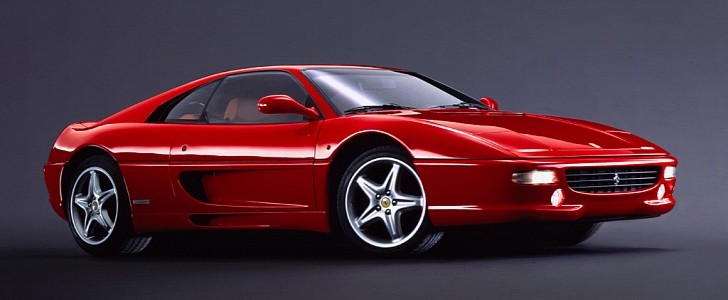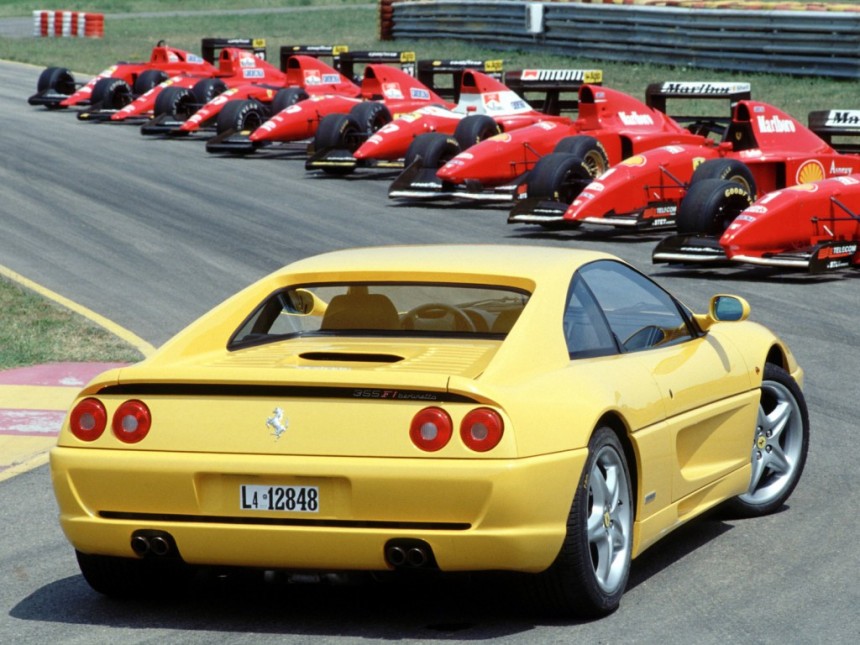Codenamed F129, the F355 is one of the most recognizable Ferraris ever made. Derived from the Testarossa-inspired 348 and thoroughly upgraded to keep newcomers like the Honda NSX at bay, the mid-engine super sports car is the first V8 model launched in the post-Enzo Ferrari era.
Presented in March 1994 at the Geneva Motor Show, the F355 entered production two months later in Maranello alongside the 456 GT and 512 TR. Despite its entry-level status, the F355 was three seconds quicker than the 512 TR around the Fiorano test circuit. As for the 348 it replaced, make that seven whole seconds, which is tremendous on a three-kilometer track.
Built around a steel monocoque just like its predecessor, the F355 features a tubular subframe out back. Designed to be dropped out for maintenance purposes, the rear subframe complements the rear suspension and the glorious 3.5-liter V8 that boasts five valves per cylinder for a total of 40.
A member of the Dino family, the F129 B engine had the highest specific output per liter of every naturally-aspirated production engine in 1994. Capable of spinning to 8,500 revolutions per minute, the B version was replaced by the F129 C in 1998. Come 1999, production came to a grinding halt with 11,273 units split between three body styles: Berlinetta (two-door coupe), Spider (two-door convertible), and GTS (two-door targa top).
Gifted with a 2,450-mm (96.5-in) wheelbase just like the 348, the F355 came with power steering and a smooth undertray for improved aero. Unequal-length wishbones, coil springs, electronically-controlled shock absorbers, and beefy anti-roll bars also need to be mentioned, along with a nolder profile and a fairing that generate a little more downforce at high speeds.
The suspension has only two settings: comfort for day-to-day scenarios and sport for corner-carving shenanigans. Stopping power comes courtesy of 300- and 310-mm brake discs with switchable Teves ABS. From 1997 onwards, Ferrari changed to Bosch ABS that didn’t have an on/off switch.
Fitted with 18-inch magnesium wheels and Pirelli tires, the F355 rocks a slightly wider track out back to improve handling. An 88-liter fuel tank is located between the passenger safety cell and the flat-plane V8.
Rated at 375 horsepower (380 PS) and 268 pound-feet (363 Nm), the 3.5er is rocking a 90-degree angle between the cylinder banks, forged alloy pistons, titanium con rods, an 11:1 compression ratio, and Bosch Motronic 2.7.
Ferrari upgraded the ECU to Motronic 5.2 for the 1996 model year. The more advanced system can be identified via the separate airbox inlet pipes. These vehicles are further equipped with a different exhaust system and a steering wheel featuring four spokes instead of the old three-spoke design.
Come 1997, the Prancing Horse introduced the F1 gearbox in the guise of a two-pedal manual with an electro-hydraulically operated clutch. Quoted with 150-millisecond upshifts, the automated manual can be operated in sport or touring mode. Fully automatic mode is offered as well, but “jerky” would be the best adjective to describe this particular setting. Vehicles fitted with the paddle-shift gearbox were marketed as 355 F1 instead of F355.
Replaced by the 360 Modena in March 1999 at the Geneva Motor Show, the F355 went out with a bang. The Spider Serie Fiorano was initially expected to sell 100 units, but Ferrari actually delivered 104 cars: 100 examples for the U.S. market, three for Europe, and one for South Africa.
This end-of-line model stands out through the Fiorano handling package, carbon-fiber interior package, blacked-out rear grille, Scuderia Ferrari wing shields, and a metal plaque affixed to the passenger side of the dashboard.
If you’re in the market for an F355 as a weekend warrior, be warned that cars without a full service history are pretty troublesome. In terms of common issues, there’s not a lot to speak of, although the Spider’s canvas top is up there with the best-known issues. Thankfully for would-be owners, the electro-hydraulic soft top can be easily converted to manual operation.
And finally, the most expensive maintenance cost is the notorious engine-out service. Recommended every three to five years or 50,000 kilometers (30,000 miles), this procedure costs well over $10,000 in parts and labor.
Built around a steel monocoque just like its predecessor, the F355 features a tubular subframe out back. Designed to be dropped out for maintenance purposes, the rear subframe complements the rear suspension and the glorious 3.5-liter V8 that boasts five valves per cylinder for a total of 40.
A member of the Dino family, the F129 B engine had the highest specific output per liter of every naturally-aspirated production engine in 1994. Capable of spinning to 8,500 revolutions per minute, the B version was replaced by the F129 C in 1998. Come 1999, production came to a grinding halt with 11,273 units split between three body styles: Berlinetta (two-door coupe), Spider (two-door convertible), and GTS (two-door targa top).
Gifted with a 2,450-mm (96.5-in) wheelbase just like the 348, the F355 came with power steering and a smooth undertray for improved aero. Unequal-length wishbones, coil springs, electronically-controlled shock absorbers, and beefy anti-roll bars also need to be mentioned, along with a nolder profile and a fairing that generate a little more downforce at high speeds.
The suspension has only two settings: comfort for day-to-day scenarios and sport for corner-carving shenanigans. Stopping power comes courtesy of 300- and 310-mm brake discs with switchable Teves ABS. From 1997 onwards, Ferrari changed to Bosch ABS that didn’t have an on/off switch.
Fitted with 18-inch magnesium wheels and Pirelli tires, the F355 rocks a slightly wider track out back to improve handling. An 88-liter fuel tank is located between the passenger safety cell and the flat-plane V8.
Ferrari upgraded the ECU to Motronic 5.2 for the 1996 model year. The more advanced system can be identified via the separate airbox inlet pipes. These vehicles are further equipped with a different exhaust system and a steering wheel featuring four spokes instead of the old three-spoke design.
Come 1997, the Prancing Horse introduced the F1 gearbox in the guise of a two-pedal manual with an electro-hydraulically operated clutch. Quoted with 150-millisecond upshifts, the automated manual can be operated in sport or touring mode. Fully automatic mode is offered as well, but “jerky” would be the best adjective to describe this particular setting. Vehicles fitted with the paddle-shift gearbox were marketed as 355 F1 instead of F355.
Replaced by the 360 Modena in March 1999 at the Geneva Motor Show, the F355 went out with a bang. The Spider Serie Fiorano was initially expected to sell 100 units, but Ferrari actually delivered 104 cars: 100 examples for the U.S. market, three for Europe, and one for South Africa.
This end-of-line model stands out through the Fiorano handling package, carbon-fiber interior package, blacked-out rear grille, Scuderia Ferrari wing shields, and a metal plaque affixed to the passenger side of the dashboard.
If you’re in the market for an F355 as a weekend warrior, be warned that cars without a full service history are pretty troublesome. In terms of common issues, there’s not a lot to speak of, although the Spider’s canvas top is up there with the best-known issues. Thankfully for would-be owners, the electro-hydraulic soft top can be easily converted to manual operation.
And finally, the most expensive maintenance cost is the notorious engine-out service. Recommended every three to five years or 50,000 kilometers (30,000 miles), this procedure costs well over $10,000 in parts and labor.
























